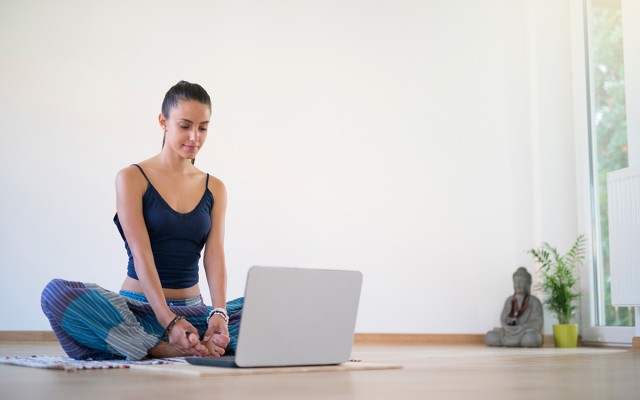The Difference Between Worry, Stress, and Anxiety—and How to Work with Each

May 20, 2020
by Tracy Foster
We are living in an unsettling time of uncertainty, isolation, fear. We’re feeling worry, stress, and anxiety, and struggling to find calm, clarity, and connection.
So what’s the difference between the first three—and how do we access the second trio?
Worry: Worry happens when the mind frets and obsesses on real or imagined troubles. “Worry tends to be repetitive, obsessive thinking. It’s the cognitive component of anxiety,” says Melanie Greenberg, author of The Stress-Proof Brain. Worry can be productive, helping us to problem-solve and leading us to skillful action. When unchecked, however, worry can lead to increased stress and anxiety.
What to do about worry: Notice when you’re stuck in a worrying loop and remember that you have choices. Decide whether you want to write your worries down, or choose to be with the worry for a fixed amount of time, and then consciously redirect your thoughts to something else.
Stress: Stress is a physiological response to an external stimulus or trigger, which shows up as physical and physiological tension, increased heart rate, shallow breath, rising cortisol levels—a general lack of ease.
What to do about stress: It is vital to remember that we have de-stressing practices available to us, such as exercise, walks outside, meditation, nourishing ourselves with healthy food, getting enough sleep, listening to music, coloring, gardening, dancing, crafting, bonding with your pet … the list goes on.
Anxiety: Anxiety is what happens when worry and stress merge into a 24/7 state of being. Anxiety shows up in many ways: dread, despair, resentment, procrastination, insecurity, projection, defensiveness. These can all feel overwhelming, like turbulent storms above and around us.
What to do about anxiety: We have skillful tools available for calming the worrying mind and relaxing the stressed-out psyche and body. Let your breath flow slow and deep, and scan your physical body, inviting areas of holding and tension to soften. Use all the self-care tools and practices listed above; you can find more here.
In his poem "The Guest House," the 13th-century Sufi poet Rumi encourages us to greet and accept whatever life throws at us—joy or sorrow, pandemic anxiety, too— without fear or loathing, and with whatever subtle faith we can connect to:
This being human is a guest house.
Every morning a new arrival.
A joy, a depression, a meanness,
some momentary awareness comes
as an unexpected visitor.
Welcome and entertain them all!
Even if they are a crowd of sorrows,
who violently sweep your house
empty of its furniture,
still, treat each guest honorably.
He may be clearing you out
for some new delight.
The dark thought, the shame, the malice.
meet them at the door laughing and invite them in.
Be grateful for whatever comes.
because each has been sent
as a guide from beyond.
In the Buddhist tradition, we are encouraged to greet and name all our feelings as friends and teachers, even anxiety. Meditation teacher Sharon Salzberg suggests we invite “anxiety” in for tea; she continues, it’s not necessary to have anxiety stay for dinner or spend the night, but she asks us to consider being brave and loving enough to include all.
Similarly, in Kripalu’s RISE program for stress resilience, we practice ways to strengthen our container of support so we can show up for whatever arises, skillfully and with compassion. We practice the 3Cs: embody Calm, cultivate Clarity, and deepen Connection.
Embody Calm
To embody calm, you simply bring awareness to the breath, welcoming attention to the natural breath moving on its own. I think of this as befriending the breath. Try this Letting-Go Breath three to five times: Take an easy, full breath in through the nose and out through the mouth with a sigh or sound … ahhh. Notice how you feel. Maybe you’re just a little more calm, a little more grounded. The Vietnamese monk Thich Nhat Hanh says, “Conscious breathing is practicing peace.” Paying attention to the breath lands you in the here and now; it’s a doorway to coming home to yourself.
Come back again to your breath and feel it flowing in and out, belly expanding as you breathe deeply. I love the simplicity of Sharon Salzberg’s teachings on meditation with breath as the anchor. She says, “Let the breath come to you. You’re already breathing anyway, so all you need to do is feel it. If you find you’ve wandered off into thinking about the past or future, no worries; simply come back to feeling the breath breathing.” You can experiment with allowing the breath to flow smooth and easy, in and out through your nostrils. Welcome calm in as you connect to the support of your breath. If you’d like, you can add this mantra from Thich Nhat Hanh: Breathing in, I calm body and mind. Breathing out, I smile.
Together with awareness on the breath, scanning the physical body and inviting areas of held tension to soften is also a way to embody more calm. See if you can relax the muscles in your jaw, shoulders, chest, belly, palms of the hands, etc. When you soften around holding, healing energy can flow more smoothly.
Cultivate Clarity
The more you meet yourself, just as you are, breath breathing and body softening, the more you are able to cultivate clarity and perspective. This means you allow yourself to feel whatever you’re feeling, here and now. You become curious about the flow of sensations you find—whether pleasant or okay or meh or maybe momentarily unpleasant—and you greet all that arises with equanimity, with no need to fix or analyze. You become the kind, wise observer, noticing the sensations of the physical body, thoughts of the mind, and emotions of the heart as they come and go like clouds passing by in a spacious sky. You see if you can connect to the part of you that doesn’t need to react or judge. You surrender and allow yourself to simply be.
This is challenging, I know. It’s a big ask, because most of us like to do, think, take control, and multitask. I ask you to consider, however, inviting nonjudgmental, patient, kind awareness to support you, just as you are, here and now. Receive one breath at a time. Soften your grip around expectations and open to a more expansive perspective. You are a “guest house.” Calm. Clear. Connected.
Deepen Connection
Meet your anxiety with compassionate awareness, expanding like a protective harbor of hope and calm. Amid the shifting sands of this pandemic, you can make use of practices that deeply support you, to meet whatever arises. Also, invite in tiny moments of gratitude, sprinkled throughout the day—ordinary little miracles, like sunlight filtering through tree branches, birdsong, the sound of laughter or a favorite piece of music, the smell of coffee, the beauty of the sky.
Then, say yes to all the little (and big) ways in which you can be an exemplar of calm, caring, hope, and compassion at home; in your community (practicing social distancing and virtual connection); with our planet and the more-than-human world of woods, stream, and air; and with all beings. Remember, we’re all in this together, one breath at a time.
Tracy Foster, RYT 1000, is a Kripalu R&R faculty member, compassionate Kripalu Yoga and meditation teacher, and Mindful Outdoor Guide.

